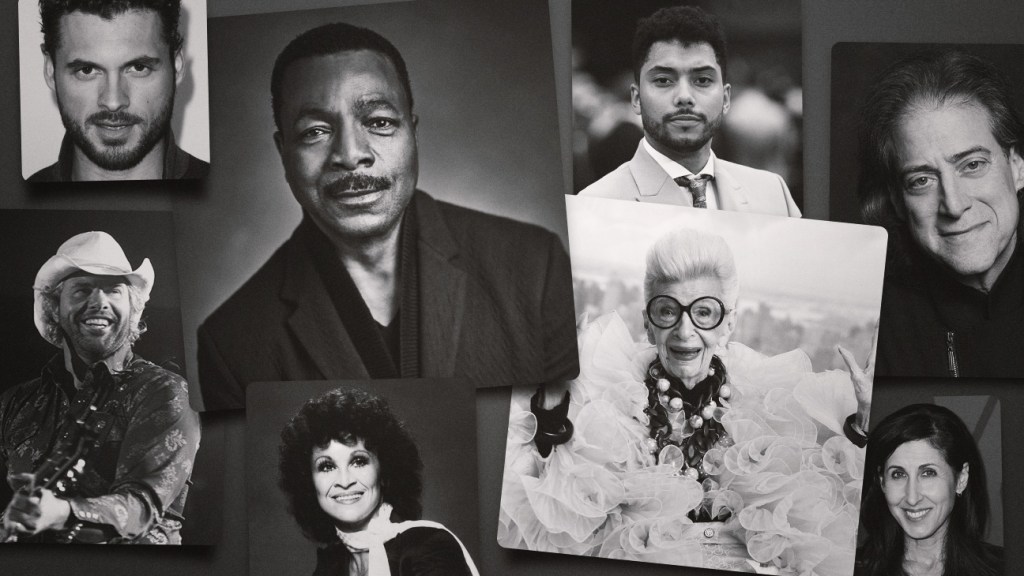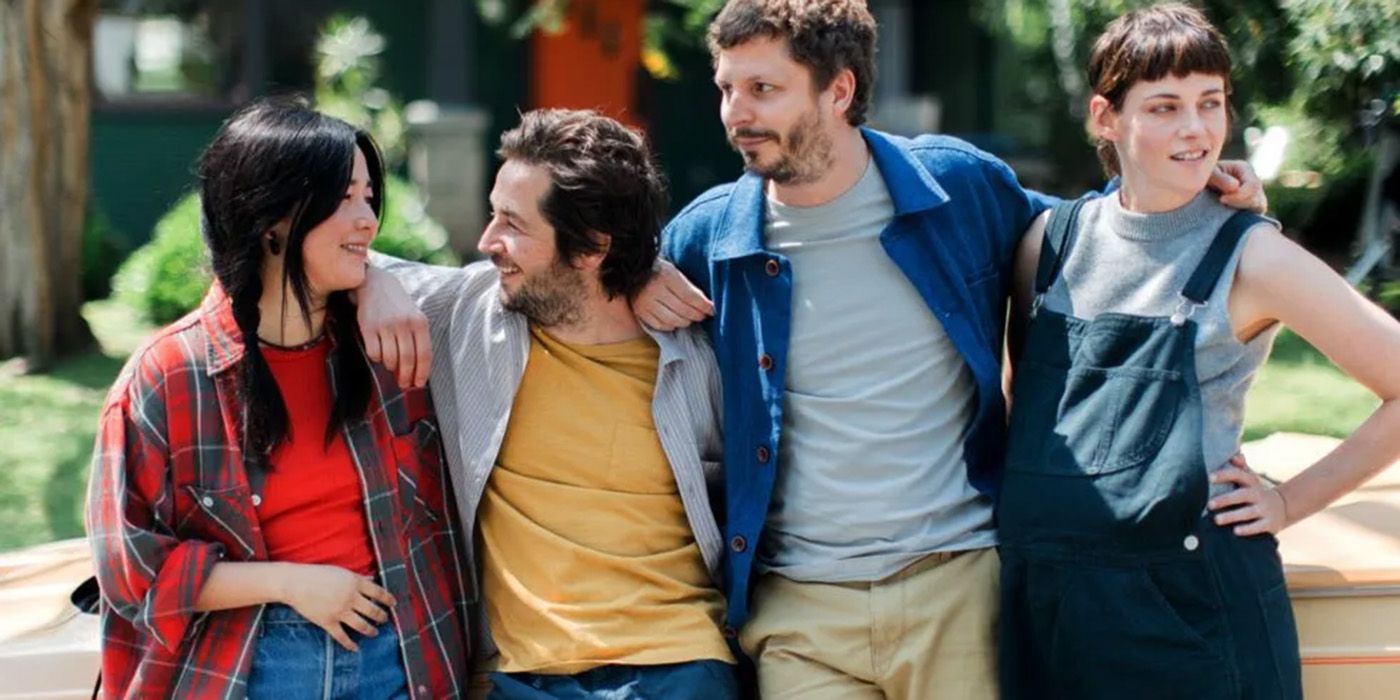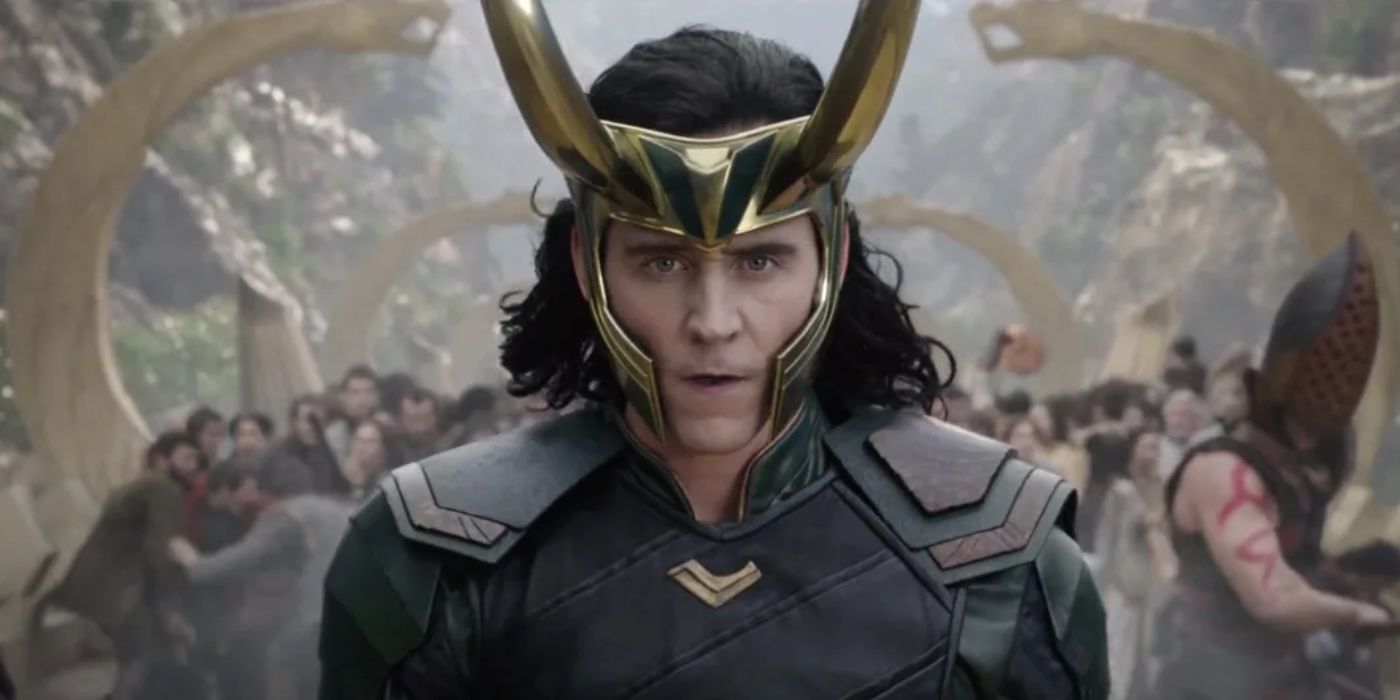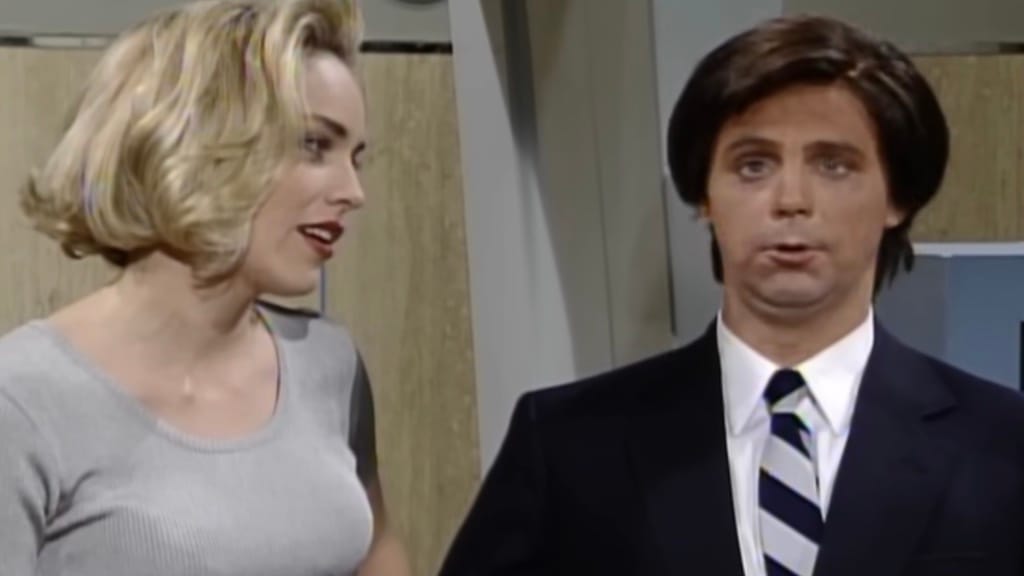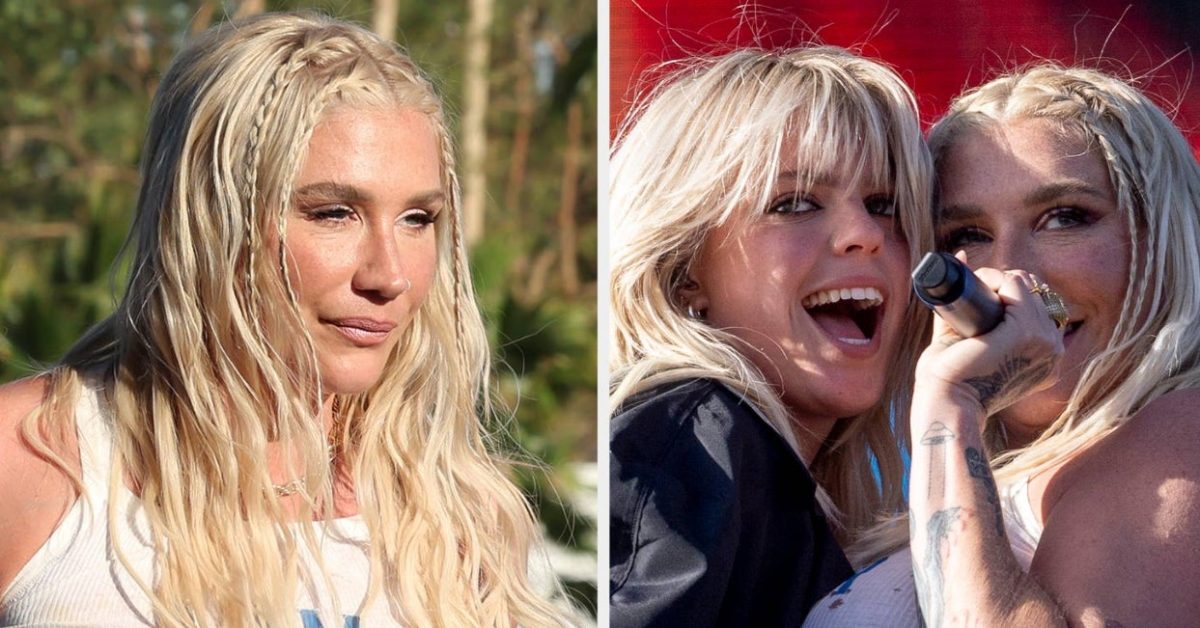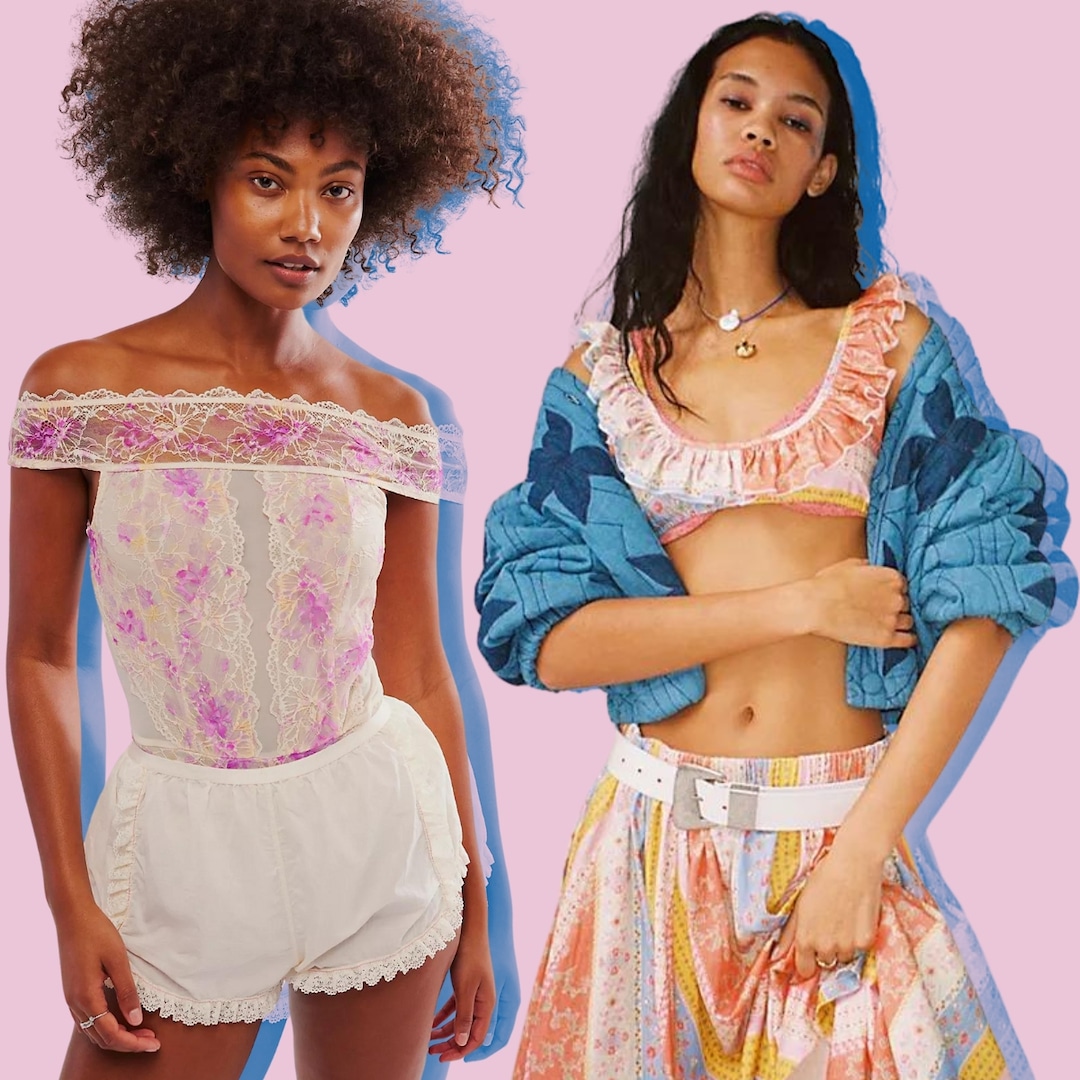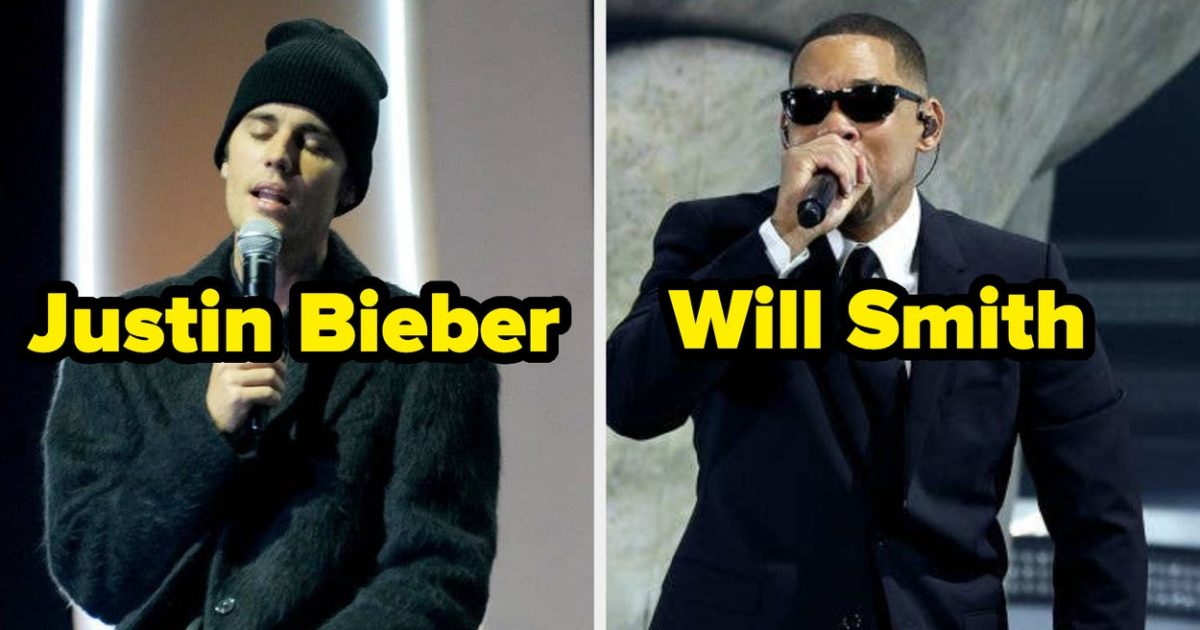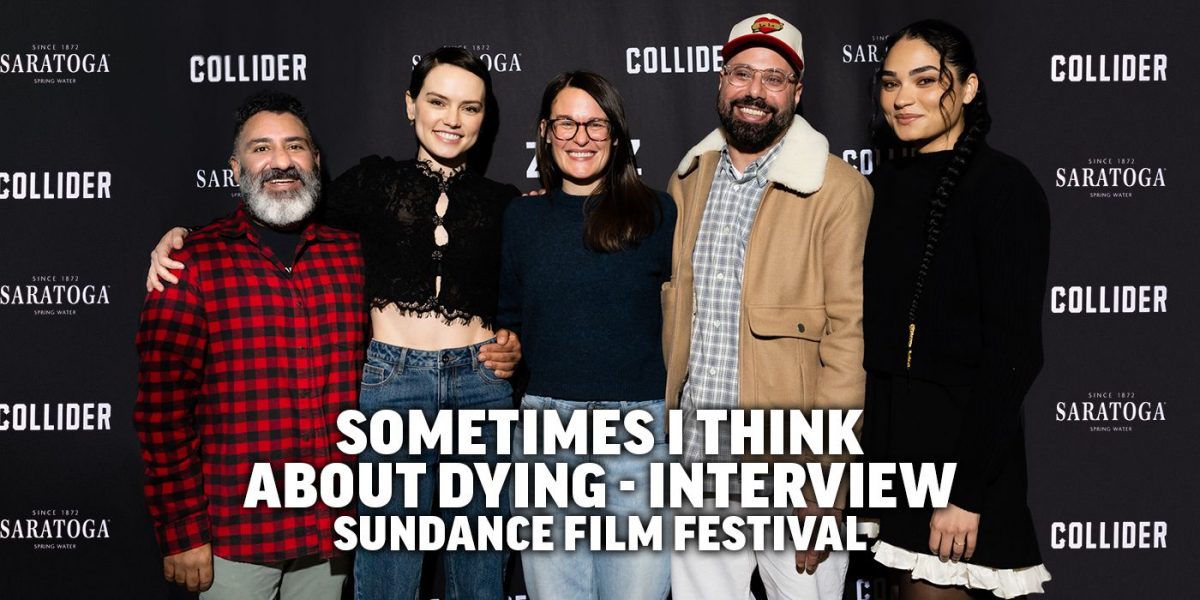
Daisy Ridley Discusses Sometimes I Think About Dying at Sundance 2023
Feb 3, 2023
One of the films that premiered at this year’s Sundance Film Festival was director Rachel Lambert’s touching comedy-drama, Sometimes I Think About Dying, starring Daisy Ridley. Adapted from a short, the movie follows the somewhat awkward Fran (Ridley) through her day-to-day, from the workplace to home, and rinse, repeat. Finding comfort in her mundane routine, Fran is a restrained woman, opting to withdraw into her own mind rather than engage with co-workers or the outside world. As the title suggests, she sometimes even considers the alternative to this life.
When Fran meets her new co-worker, Robert (Dave Merheje), an overly amicable and social fellow, the two strike up a friendship. Robert sees the quiet humor Fran possesses, and even manages to coax bites of information about Fran from her disciplined timidity. Through their growing relationship, Fran begins to slowly reveal more of herself and learns to find comfort in the world around her rather than just in her mind.
After Sometimes I Think About Dying’s Sundance screening, Lambert, Ridley, Merheje, Parvesh Cheena, and Brittany O’Grady came by the Collider Studio presented by Saratoga Spring Water in Park City. During their interview with Collider’s Steve Weintraub, they discuss embracing the small details in life, what drew them each to the script, from diversity to vulnerability, and how freely they were allowed to play with that script. Lambert also explains the importance of the cast’s authenticity while onset and improvising their characters, the set design’s impact on the story, and how the editing process changed the film from what even the actors expected. For all of this and more, you can watch the interview in the player above, or read the full transcript below.
Image via Photagonist
COLLIDER: I want to say sincere congratulations on being part of Sundance. Most people who are watching this will not have seen the movie yet, and they might not have seen the short film that it’s based on. How have you been describing it to friends and family?
RACHEL LAMBERT: Well, I’ve been describing it as, a woman named Fran who lives in a small seaside town and she lives a very simple life, but she’s pretty convinced that everyone else around her is really good at being a person and she’s not. She feels it’s really hard to connect with others even though I think deep down she really wants to. I think that she is unsure of how to live life in a meaningful way. I think that she is searching for some way to make sense of that feeling of being lost and lonely.
That’s really where she’s at, but the story that we follow is one of her learning how to find joy in the very small idiosyncrasies of life, that that’s actually the secret. It’s not some big amazing event that descends on you and helps you transcend life. It’s actually focusing on the details of what you had for breakfast, enjoying that, looking in someone’s eyes, having conversation, and sharing tea. That’s actually the secret, it’s really simple. But she gets there in a way that’s really funny, it’s actually quite comic and heartwarming and sometimes heartbreaking.
And fun conversations on Slack.
LAMBERT: Oh yeah. Yeah. But seriously, that’s how we occupy our time, right? I’ve never jumped out of a plane. I don’t know what it’s like to save humanity, but I do know what it’s like to share a joke with a friend over text, and that really making your day. I know what it is to surprise someone with a muffin for breakfast and that sparking a conversation, and it soothing maybe an otherwise really tedious day. Those are the dramas of my life and I don’t think that makes them small dramas or insignificant. I actually think they’re really significant.
Exactly. For all four of you, what was it about the script and story that said, “Oh, I absolutely want to do this. I have to do this.”?
DAISY RIDLEY: I’m actually also going to steal a bit of Britt’s answer from yesterday, too. I mean, initially, I just think the script was beautiful. I thought the character was wonderful, but also the setting was beautiful. I always got to the end and however many times I read it before we got there, I always cried at the end. It’s the, I think, “Do you wish you could unknow me?” is the saddest thing I think I’ve ever read, but also the tiny victory of someone establishing some sort of connection, which is the most difficult thing for them, was always beautiful.
And to Brittany’s point – sorry – It was also just the thought of being part of a group of people. And honestly, it exceeded expectations. We actually love each other so much, and we had such a great time on set that it was really wonderful to be part of a group of people who were so distinct and unique, and Rachel really let everybody live their best, beautiful lives on film.
DAVE MERHEJE: I’m just going to take Daisy’s answer and say it was a beautiful script and everybody’s great. But I did connect with Fran’s character. I’ve gone through some of that stuff and still go through some of that stuff, so I wanted to be a part of it. I got really sad by the end of it.
PARVESH CHEENA: Sure, but now do you feel happy?
MERHEJE: Looking into your eyes, I do.
CHEENA: Bless you. I love you, too. Brittany, can I go next? Do you mind?
BRITTANY O’GRADY: Yes, please.
CHEENA: I always forget about this with this project. My character’s name is Garrett, and when you’re Parvesh, you don’t get to play a lot of Garretts often. You don’t get to play a character where it’s just the character first, where we don’t have to deal with, “What’s his orientation? What’s his race?” And then, knowing that Dave was in as the male lead, romantic lead in a sense, we don’t get to do that often.
MERHEJE: I mean, I don’t look like–
CHEENA: No, don’t do that. Don’t do that. We’re on an up, we’re on an up. You do belong.
MERHEJE: Yeah.
Image via Photagonist
CHEENA: We do belong, and we are a part of this world. I’ve spoken with Rachel about this, it was so casually diverse. We have people with disabilities, we have every color, every race under the rainbow, but that’s not the priority. It’s still the story of Fran and connecting in loneliness. But for me, that is a big draw. That is a big draw.
I don’t want to swing that pendulum. I am not shy of my Indianness or my gayness, but even my own partner asked, “Was your character gay?” I’m like, “Up to you to decide.” And so that was just a gift for some of our actors. We have to view it with that lens before we even read the script. And then seeing Rachel’s other film was my big reason why I wanted to do it. Brittany, my love.
O’GRADY: The script, actually, it scared me a little bit when I read it just because it was so vulnerable. I think feelings that Fran and many of us feel [are] a really terrifying thing because we always keep it in the shadows. And just being able to be a part of creating the environment and helping make that atmosphere come to life, and with the contrast of the outside world and Fran’s internal monologue, which we see on Daisy’s face, but it’s not – it was there in the script.
LAMBERT: We talked about public and private a lot didn’t we?
O’GRADY: Yes, we did.
LAMBERT: I remember that.
O’GRADY: So that was a reason why I wanted to be a part of this, and it was a wonderful experience.
First, I want to address what you said, which I totally agree with. I think that it was, it’s great when films have that diversity, but that’s not the point, but it’s part of it. It’s that it’s real. And that’s one of the things that I really loved about the film is just real people.
CHEENA: Absolutely.
LAMBERT: Celebrating it.
Exactly. Obviously, the office setting is everything. If that doesn’t work, this movie does not work.
LAMBERT: Yes.
Image via Photagonist
So talk a little bit about filming the office settings. Was it all done at once, and how did you want to shoot it and play it to make it feel like this has been happening for years and years?
LAMBERT: That was a huge concern. Not in terms of negative concern, but just something that occupied my thoughts, I’m sure their thoughts, all of my department heads’ thoughts when we were prepping, because that was so much of a lifeblood of the story, as you said. It definitely started with design and thinking about, “What is this place?” And the script was written with so much invitation for my own creativity to take hold. Then, the writers all being from the theater, they were incredibly specific in the psychologies of the actors, the motivations, all the food you need to make good decisions, but there was so much space to invent. And I got to sort of decide, “Okay, where is this office? What is it? What do they do? Where are they at?”
When I went to Oregon, I saw this fishing world, this port world, and the seaside world, and I wanted to engage with the environment there, the industries there, and really showcase a sense of play. So that was the first thing. And then from there, we created an environment that had to look lived in. I wanted it to look like this was a place that maybe got renovated in 1992 and still hasn’t seen new anything. I wanted to make sure that the actors all had… Their desks were designed with some character in mind where they could interact with their computers. They had assets they could play with.
CHEENA: You had us bring talismans.
LAMBERT: You had to bring five pieces, but you couldn’t show me until we were there.
CHEENA: Nope.
LAMBERT: And sometimes they were kept as secrets.
RIDLEY: And I brought nothing.
LAMBERT: Well…
RIDLEY:I had to fly a long way. So I was like, “Can I fit five things in my bag?” But also I was like, “Fran wouldn’t have things on her desk.”
LAMBERT: No, but that’s the right choice. I mean, just like positive space and negative space, either is an additive. And I think that was the right choice, and that still worked and it worked very well. So that contributed to it.
And then in terms of shooting it, obviously we had these scripted pieces, and I know (cinematographer) Dustin [Lane] and I wanted every angle to be fresh. We never reused a setup for any given scene. That kind of variety allowed us to maximize the photographic and emotional potential of this space that we didn’t want to feel too tired in terms of how we’re engaging with the image, because we also knew that it was designed to be kind of… tired in terms of its aesthetics. So there was that idea. And then, with the aliveness, and even what you were saying about humanity being so important to characterizations, it was very important to the storytelling. So I let them play
CHEENA: You absolutely did. Rachel is one of the most gentle directors I’ve worked with. There would be times when we would – it was theater camp, so we were also just hanging out and I’m just in character all day. And then we’d be talking and then all of a sudden you’d see Rachel be like, “Brittney go.” And I’d be like, “Oh, we’re filming.”
LAMBERT: Or you’d see Dustin and the camera team kind of spider over to corner.
CHEENA: And turn the camera on. I’m like, “Oh, let’s just keep going.” That was so much playing.
LAMBERT: It was encouraged that they would live in their spaces, that the idle time would be used as playtime. Even in scripted scenes, like the conference room scene, where we let people’s instincts run. And they’re so great a company. I mean, it was like we were a rep company. They would do it. We’d do a couple runs, and we’d be improvising, but we would know what was working – or they would know as a company what was working, and they would remember those beats. So even we went back to the edit, we had cut points everywhere because they go, “Oh, that beat’s working.” And they would still make sure that we could get that set like a good theater company.
CHEENA: And no improviser likes when you repeat stuff. I love that the writers gave such freedom with the script and so much room for play. But you have the parameters, the improv within scripted works. You have to go by that. You can’t say like, “Oh, I have 10 kids.” Like, “Act One you said you have none.”
LAMBERT: That’s right.
MERHEJE: 10 kids, so specific.
CHEENA: There are moments that you do remember: just stay within these confines.
LAMBERT: You have a playable reality in given circumstances. And then that sets your limits, which then actually opens the door to opportunity and choice as an actor, I think.
Image via Photagonist
How long did you have to actually make the movie? Was it a 20-something day?
RIDLEY: Have a guess. Have a guess.
25 to 35?
RIDLEY: 18.
LAMBERT: 21.
RIDLEY: Was it 21? Was it?
LAMBERT: Yeah. Because we had a day where we did a lot of the stuff with the visions.
RIDLEY: Yes, and you went off and did all the seaside stuff.
LAMBERT: Yeah, yeah, yeah.
RIDLEY: But I will also say, we wrapped early many days. And I’m talking like hours early. Rachel was very deliberate and very intentional and knew what we needed to get, and we got it. And that was that.
LAMBERT: And I was blessed with the company too. Yeah.
Here’s the thing though, it’s very hard when you’re not a Marvel movie or a mega-budget movie. Financing is really, really hard nowadays, and you don’t have a lot of time. You have to do everything on a very tight schedule.
RIDLEY: I was just going to say, everyone had to hunker down. There were a lot of financial sacrifices made for individuals, particularly the producers, in coming in and making it work. And people were doing five different jobs, and one of our producers was our first AD. Everyone was doing that. So it really, not just cast-wise, crew-wise it really felt like a company too.
So obviously when you’re making a film with a tight schedule, and you’ve got to hit your marks and days, for all four of the actors, I’m curious, what day did you have on the schedule that you had circled where you’re like, “Oh, this is going to be a really tough day.”? Or was it every day?
MERHEJE: I was going to say every day. No… [laughs]
CHEENA: The first day was nervous, meeting everyone.
MERHEJE: I was nervous [for] probably a week and a half. I wasn’t completely nervous the whole time, but the highest in a week and a half. But I think the boathouse was–
LAMBERT: Yeah, we knew that was going to be tough.
RIDLEY: But also, we were given a lot of room. It wasn’t like we have to fulfill all of these things and there’s no room to play in that and no room to sort of get it wrong and try things. My thing was just the house after the car because to be alone and have to do all of that. It’s the lowest point, I would say, for Fran. So I was very aware… But also by that point, we knew how amazing all the crew were in treating the set so carefully and so respectfully. So also there was a lot of comfort in that, when you know that everyone is just together on the journey.
O’GRADY: Yeah, I agree. I don’t really remember how long I was there for.
CHEENA: Maybe like a week, right? Because I only stayed a few days after you.
LAMBERT: It was a full week of shooting, yeah.
O’GRADY: For the office, I would say, I know I wasn’t there for the whole shoot, but just the experience of it. It’s so impressive to me that you guys had so many corners that had to be cut. But it was the most pleasant experience on a job I’ve ever had. And to wrap hours early and be so intentional, but then to have the freedom that we had.
LAMBERT: You guys were so good. We still had room to play. I got to play even beyond what you guys were doing. And then it was like, “Go home, rest, be prepared.” That’s more important than me indulging myself needlessly.
CHEENA: The meet and greet, our first cast and crew dinner when we all got to Astoria.
LAMBERT: Ooh, that was scary.
O’GRADY: That was scary.
CHEENA: Because I didn’t know who was who, and then, literally, I went to Dave first then.
MERHEJE: I thought it was because we were both ethnic.
CHEENA: That’s true. Yes, it’s true. I did go to my brown brother first. I was like, “I know you.” But that was the scariest part. Brittany walks in, and then Daisy – you still have that moment of the first time you meet Daisy is still like, “Oh, that’s Daisy.” And then by the end, you’re like, [deadpan] “Dais.”
But that is the most nerve-wracking because you just don’t know what it’s going to be. But after that dinner, then shooting, I hope at least for those of us in the office, was cake in the sense. Because we knew we were going to be taken care of. But literally walking into the restaurant was like, “Oh my God, please like me.” First day of school, it was that vibe.
MERHEJE: I drove to the wrong… You know that bridge? [When] I first got there, I went on that bridge, and I was like–
LAMBERT: Wait, the big one over the water?
MERHEJE: Yeah. I was like, “I’m leaving Astoria.” And I was like, “Where am I going?”
CHEENA: To Canada.
MERHEJE: I was going back to Canada.
CHEENA: Oregon to Washington, you’re back home.
Image via Photagonist
I’m never letting you drive me.
MERHEJE: I got better, bro. I got better. I did. I had a whole three weeks to practice in a rental car.
CHEENA: Daisy would drive us around. There would be a lot of times like we’d wrap early. We’re like, “Alright, let’s go to the restaurant. Let’s go to the bar.” And I’d be like, “Daisy, can you drop us off?”
MERHEJE: Or remember that haunted… you sent an article when we filmed in that town, you sent an article the next day that the town and that theater was haunted?
RIDLEY: It was the most haunted place in Oregon.
LAMBERT: Wait, the movie theater we were at?
RIDLEY: Yeah. It’s the most haunted town in Oregon.
O’GRADY: It looked pretty haunted in the film. I was like, “That’s scary.”
LAMBERT: I know it’s old.
MERHEJE: Even the deer. The deer said it was haunted. I ran into a deer.
CHEENA: Who went to The Goonies house?
RIDLEY: Oh, I did.
CHEENA: Because we were in Astoria, Oregon. So Kindergarten Cop, Free Willy…
RIDLEY: We went to the film museum, which was an old jail. Fun.
CHEENA: Really? I didn’t make it there.
RIDLEY: I literally went round it in 20 seconds, but it was great.
Isn’t Astoria The Goonies?
CHEENA: Goonies, Kindergarten Cop, Free Willy, and Sometimes I Think About Dying.
LAMBERT: Yes, yes.
The Goonies is actually one of my favorite films. Anyway, that’s a completely separate thing. I like talking about editing because it’s where the film obviously comes together. So how did the film change in the editing room in ways that perhaps you weren’t expecting?
LAMBERT: [There are] definitely specific scenes and moments that metamorphosed or developed in the edit, but we were anticipating that it might. But we were opening ourselves up to discovery based on the bits that we found. Because, as we mentioned, there was a lot of play, and we wanted to fill out that environment and that world with all of these idiosyncrasies, relationships, beats. So we anticipated a lot of the office to be a lot of invention in terms of, “How do we build that into the spine of the written story?” So there was that aspect of it.
And then there’s a section you mentioned with Slack screens, and we definitely had that conversation in the script, but (editor) Ryan [Kendrick] and I really wanted to find something that continued to create this sense of 360 life, to have their conversation be rooted in an ongoing reality that is sort of ricocheting off of it emotionally. We thought it would create a unique kind of energy. It would also heighten the sense of how she’s behaving around others, we wouldn’t lose touch with that, how our outsides can be interacting with our insides. So we wanted to have this other energetic conversation, somewhat hilarious conversation going on around them. And so it kind of came out as this Altman-esque moment of 360 life, conversations going on all around, the Slack screen. It kind of heightened, almost, to a Keaton-esque mania, or something. So that was really fun to discover that.
And then the opening was an entire discovery as well. We knew we wanted to have about a handful of really intentional photographs that could live as their own pieces of still art, if need be, and they had to follow certain rules when we shot them. They had to be something that Fran would notice or see if she was walking to or from work in the morning or the evening. So it also had to be at certain times of the day that would believably be on her walk. And it had to connect with the things that she’s feeling: loneliness, the beauty of the unseen, strange thing, nature in places it shouldn’t be, that merging of the fantasy and reality. So we had those things, but what is that arrangement? What is the associative grammar telling the audience? Not only what is each image saying, but what is that progression? And marrying that with a piece of music that had to be designed, as well, by Dabney [Morris]. It was a huge collaboration, that opening, [between] me, Dabney, and Ryan. I hope that answered your question.
Image via Sundance
No, 100%. The interesting thing about doing a Sundance interview is that I have so many specific questions, but because no one has seen the movie, I don’t want to spoil anything. I can’t ask you about any party scene and bathtub sequence. I’m trying to avoid, but still say words that people might–
RIDLEY: Also, that sounds totally different than what it is. I will actually say, on the editing front, in a general way, which I found very interesting is, the more “emotional” – if one should call it that, which one shouldn’t, because everything is an emotion – the more demonstrative emotional scenes for Fran, you trimmed a little. And I found it interesting because I was like, “Oh, okay, cool.” So it felt a little less sentimental from what we filmed to what I saw. It was quite profound because then when my mom saw the film, she was so overwhelmed with emotion that I was like, “Huh, what do you know?” And it was a really–
LAMBERT: So, you’re meaning some of the scenes where you’re talking with Robert?
RIDLEY: Yeah. There’s a scene where there was a sort of leading up to it that wasn’t in there, so it is just the shot of me on the sofa. And then the end of the film where me and Dave had a scene together, you used takes which were a little more contained, and it was just a very interesting exercise because I was like, “Okay, cool.” And it still was so tangible that it was really interesting because Rachel’s spoken about the fact that there’s no agenda to what this is. It’s just a story about some people and connecting. And because there’s no judgment on it… I’m not explaining it right, but it was a very interesting editing choice, I found. Because watching it, I was like, “Oh, okay, cool.”
LAMBERT: When we were working on it, there was just more in what was being fought against as opposed to being always released. And so when there was release, it felt like you could feel the work it took for her to release at all. There [were] a couple things. One, I remember when we were getting towards the end of the shooting your own instincts as an actor, you were coming to me and saying, “I think that this line, I think I can just clip that.” And you were feeling that she doesn’t want that, you were already psychologically and emotionally pushing the character in that direction. Not only in your work, but in how you were coming to me about those scenes towards the end. And so I think it came from those instincts on your part. And it not only came from the performance, but it certainly informed me going forward.
I can’t imagine what it’s like as an actor when you have made a movie, and you’re not exactly sure, because you’ve given so much, so many different versions of a performance. You don’t really know what the movie’s going to be until you watch it. And then I can’t imagine what that is like.
CHEENA: Happily surprised. I think, for most of us, we hadn’t seen it. And I was surprised how funny it was. That’s why, coming from TV, multi-cam even, or single cam, you make friends with the editor because it’s the editor who is going to make me look like either a cloying asshole or a comedic genius. It is. Because we just say jokes, but it’s that timing, it’s that bit. Will they laugh? You build in, almost, that room for a laughter in a theater. It’s what I thought about all the time. The edit was funny.
MERHEJE: Yeah, and getting the timing. Yeah. I mean what you said.
CHEENA: Thank you, Dave. Thank you, Dave.
Image via Photagonist
Listen, I have to wrap with you guys, but Daisy, I think you’re starting to film a movie on Monday if I’m not mistaken, which is why you’re leaving Sundance. What would you like to tell about this project? I know it’s very personal to you.
DAISY RIDLEY: The movie follows a family, a woman who is at home with a baby, pushed slightly beyond her limits. Her husband, who is chaperoning their daughter into a film set, and who falls in love with the actress playing the mother. It’s fantasy versus reality, and what things mean and different perspectives, and what they lend to how we view characters. And also, what the audience’s biases may inform when they’re projecting onto the characters. So it’s a lot of things.
My husband, [Tom Bateman], wrote it. It’s excellent, and we have an amazing cast and crew. Honestly, from working on this, it’s just the power of what people can do together if everyone is like, “This is what we’re doing, we’re holding hands. We have limited time, we have a limited budget, this is what we have to do…” and we get to be part of amazing things.
PARVESH CHEENA: Are you the mom?
RIDLEY: I’m the mom. It’s called Magpie.
Special thanks to our 2023 partners at Sundance including presenting partner Saratoga Spring Water and supporting partners Marbl Toronto, EMFACE, Sommsation, Hendrick’s Gin, Stella Artois, mou, and the all-electric vehicle, Fisker Ocean.
Publisher: Source link
Kesha Changes Tik Tok Lyric During Coachella Appearance
I love women so much like you don’t understand how important kesha and reneé rapp are to me. I listened to tiktok on my hello kitty mp3 player on the way to school every morning and now I listen to…
Apr 19, 2024
Free People Sale Finds Under $50 You Won’t Regret Adding to Your Cart
We independently selected these deals and products because we love them, and we think you might like them at these prices. E! has affiliate relationships, so we may get a commission if you purchase something through our links. Items are…
Apr 19, 2024
Olivia Rodrigo Joined No Doubt, And Many, Many Other Artists Had Surprise Cameos At Coachella 2024
This year had some of the best surprise guests.View Entire Post › Disclaimer: This story is auto-aggregated by a computer program and has not been created or edited by filmibee.Publisher: Source link
Apr 18, 2024
Cute Kate Spade Mother’s Day Gifts That’ll Make You the Favorite
We independently selected these deals and products because we love them, and we think you might like them at these prices. E! has affiliate relationships, so we may get a commission if you purchase something through our links. Items are…
Apr 18, 2024
